Dolgarrog remembers lives lost in 'terrible' dam disaster
- Published
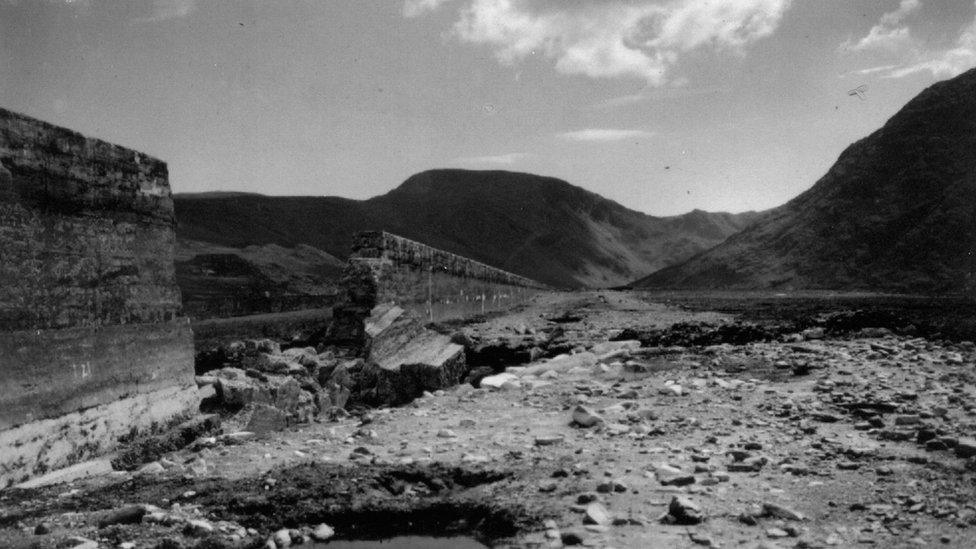
The breach in the Eigiau dam wall that led to the disastrous flood
It was a night which changed the landscape of a small north Wales village forever. Now, 90 years on, the church bell that tolled on the night 16 residents lost their lives, will ring out again in their memory.
On 2 November 1925, Dolgarrog was devastated when two dams burst, sending a torrent of water and boulders crashing down towards the village below.
The flood killed 10 adults and six children in the Conwy Valley community.
Many more watching a film in the village theatre survived. Had the building not been on higher ground, the death toll could have been far greater.
90 years ago the small Conwy Valley community of Dolgarrog was devastated after a dam failed, flooding the village and killing 16 people
"It was a terrible, terrible disaster, which affected the whole community and changed the lives of the families here," said Dafydd Williams, chairman of Dolgarrog community council.
The flooding was triggered by a failure of the Eigiau Dam, owned by the Aluminium Corporation, which was breached following two weeks of heavy rain.
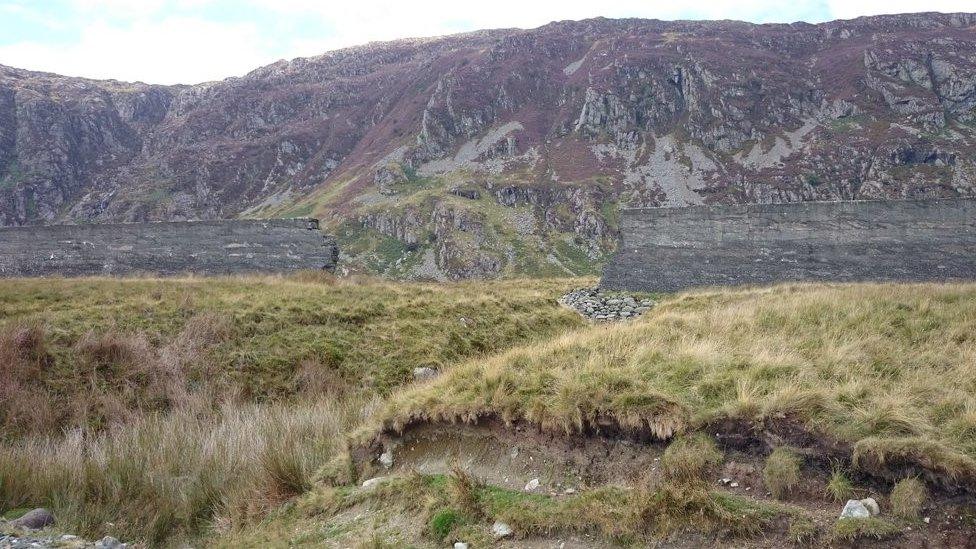
The breach in the dam, still visible now, showing the gully cut by floodwater
At about 20:45 GMT, the water from the reservoir flooded downstream, overtopping the Coedty dam. This then failed, releasing up to 70bn gallons (350bn litres) of water and debris into Dolgarrog.
Within 20 minutes, the water had flooded across the main road, swept away houses on Machno Terrace, the church, church house, sweet shop, butcher's and water mains.
The church bell is said to have rung out three times just minutes earlier.
Today, the only building left standing of the old village is the now-empty Porth Lwyd Hotel.
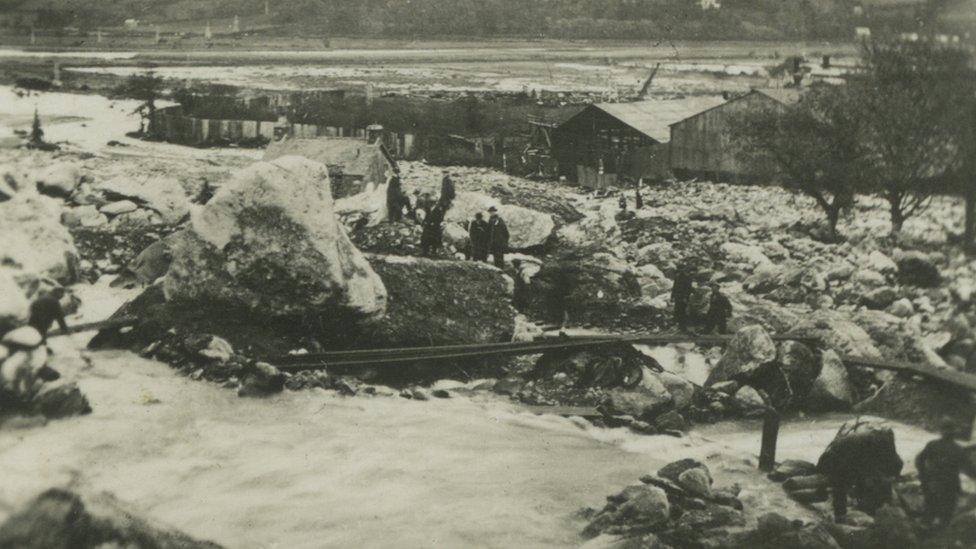
Villagers using planks to cross Dolgarrog following the dam disaster
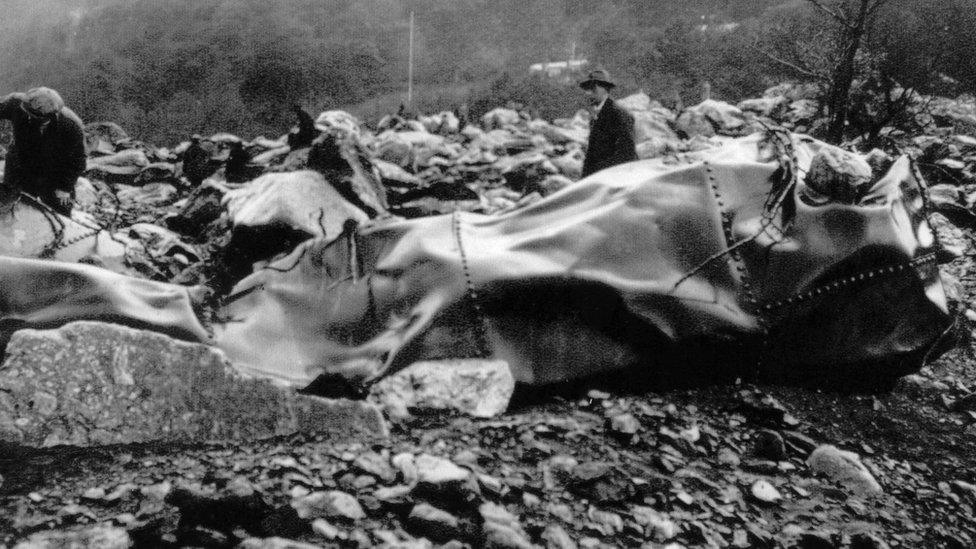
A water pipe washed down as part of the debris
"The flow of water from the dams did not cease until mid-morning the following day," said Gwilym Wyn Roberts, whose mother survived the disaster.
He has since carried out extensive research into what happened that night.
"Cows were seen hanging from the trees and the aluminium works were submerged under 5ft (1.5m) of mud," he added.
Mr Roberts, who was born and brought up in the village, used to play as a child on the "massive numerous boulders", some of which weighed more than 200 tonnes.
"These massive stones had been carried down with the torrent," he said.

What caused the flood?
The jury at an inquest into the lives lost at Dolgarrog returned a verdict of "accidental death", after hearing technical evidence from Ralph Freeman, external.
He claimed the flood had been "caused by the bursting of the dam under the wall in consequence of the wall lacking a proper foundation" and that this foundation "had not been sufficiently deep".
Parliamentary records, external suggest "the damage was done in the construction originally".
The investigation led to improved construction requirements for dams in the UK, as part of the Reservoirs (Safety Provisions) Act in 1930.
The act introduced laws on the safety of reservoirs and was more recently updated as the Reservoirs Act 1975., external

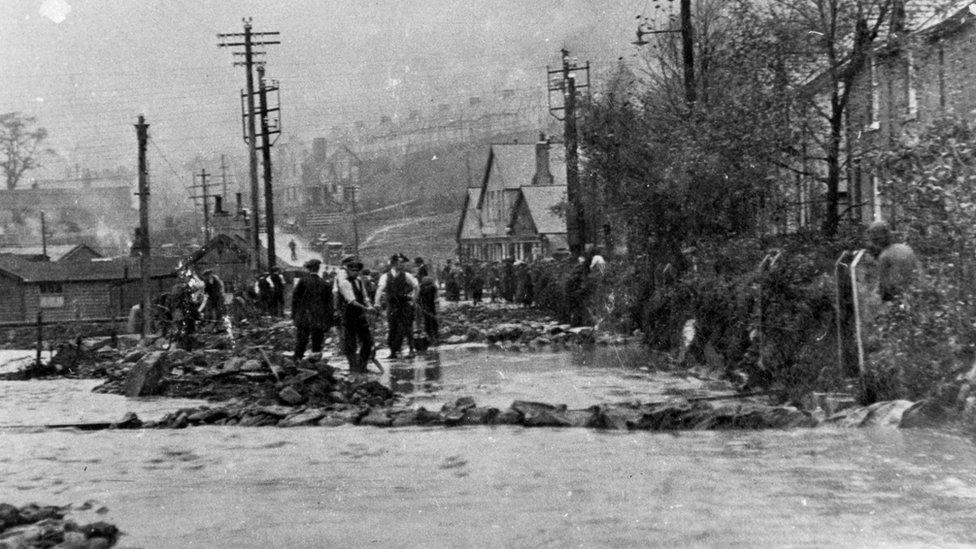
The aftermath of the disaster on the Conwy-Llanrwst Road
A memorial service is being held at St Mary's Church at 20:15 GMT, on Monday - exactly 90 years after the disaster took place.
Council chairman, Mr Williams said: "The church bell is one of the few remaining items that we have from the original church that was washed away in the disaster.
"It will be very moving when that bell is rung at the service in memory of each of the victims.
"We will be hearing something which those people once heard and which was rung on the night of the disaster."
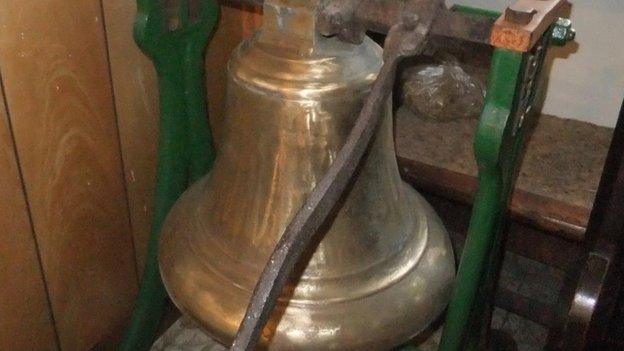
The bell from the original church
Jamie Hack, from Wrexham, is a direct descendant of four of the victims claimed by the flood: Susannah Evans and three of her children, Ceridwen, Bessie and Gwen.
Unable to attend the memorial service in Dolgarrog, he and his family will be remembering the occasion with "special prayers at bedtime".
"I will also be relating the incident as a story to my children," he said.
Susannah Mewis, the granddaughter of Susannah Evans, will be travelling from Staffordshire to the service.
"We grew up knowing of the disaster and my father (now deceased) used to talk a lot about his life in north Wales," she said.
She has since researched the deaths of her grandmother and aunties.
'Enormity'
"I read about the ways in which their bodies were found and burst into tears," she said. "The enormity of what happened will surely stay with all descendants for ever."
Fred Brown was the last remaining survivor of the flood but passed away several years ago. He was 14 when the waters came crashing down, claiming the lives of his mother and younger sister.
Mr Brown previously told BBC Wales about that tragic night: "I heard that my mother had drowned, as well as my four-year-old sister.
"My father and my elder sister were washed down with the flood and they rescued themselves by crawling over coke wagons."
The village now faces the task of preserving the memories of that terrible night, with nobody left who directly experienced it.
To do this, they are maintaining a special memorial walk, which has been built in memory of those who lost their lives.
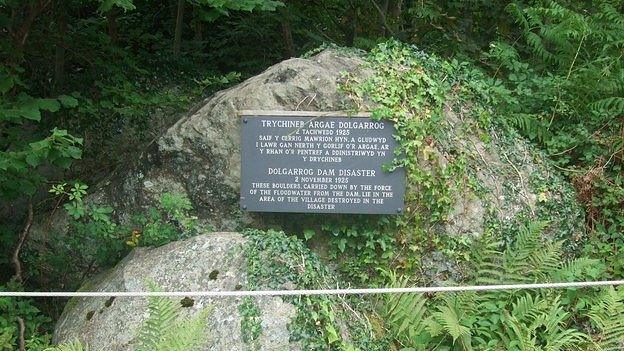
The boulders and slate plaque depicting the Dolgarrog Dam disaster
The £60,000 trail was opened in 2004, explaining the tragic story to walkers visiting the area. It follows the route the water took down towards the village, past the boulders brought down from the damaged dam.
There is also a small display in the village of photographs and newspaper clippings from the disaster, with plans to set up a permanent museum in the community centre.
"We also mark the big anniversaries", said Mr Williams, "we don't mark it every year, but the last one was the 75th anniversary and after this the next one will probably be the 100th."